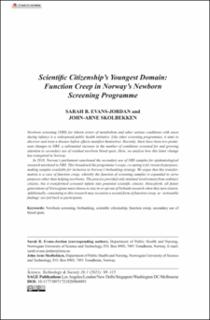| dc.contributor.author | Evans-Jordan, Sarah Beth | |
| dc.contributor.author | Skolbekken, John-Arne | |
| dc.date.accessioned | 2021-03-22T11:47:16Z | |
| dc.date.available | 2021-03-22T11:47:16Z | |
| dc.date.created | 2021-03-05T09:52:36Z | |
| dc.date.issued | 2021 | |
| dc.identifier.citation | Science Technology & Society. 2021, 26 (1), 98-115. | en_US |
| dc.identifier.issn | 0971-7218 | |
| dc.identifier.uri | https://hdl.handle.net/11250/2734806 | |
| dc.description.abstract | Newborn screening (NBS) for inborn errors of metabolism and other serious conditions with onset during infancy is a widespread public health initiative. Like other screening programmes, it aims to discover and treat a disease before effects manifest themselves. Recently, there have been two prominent changes in NBS: a substantial increase in the number of conditions screened for and growing attention to secondary use of residual newborn blood spots. Here, we analyse how this latter change has transpired in Norway.
In 2018, Norway’s parliament sanctioned the secondary use of NBS samples for epidemiological research unrelated to NBS. This broadened the programme’s scope, co-opting it for research purposes, making samples available for inclusion in Norway’s biobanking strategy. We argue that this transformation is a case of function creep, whereby the function of screening samples is expanded to serve purposes other than helping newborns. The process provided only minimal involvement from ordinary citizens, but it transformed screened infants into potential scientific citizens. Henceforth, all future generations of Norwegians must choose to stay in or opt out of biobank research when they turn sixteen. Additionally, consenting to this research may occasion a second form of function creep, as ‘actionable findings’ are fed back to participants. | en_US |
| dc.language.iso | eng | en_US |
| dc.publisher | SAGE Publishing | en_US |
| dc.rights.uri | http://creativecommons.org/licenses/by/4.0/deed.no | * |
| dc.title | Scientific citizenship's youngest domain: Function creep in Norway's newborn screening programme | en_US |
| dc.type | Peer reviewed | en_US |
| dc.type | Journal article | en_US |
| dc.description.version | publishedVersion | en_US |
| dc.source.pagenumber | 98-115 | en_US |
| dc.source.volume | 26 | en_US |
| dc.source.journal | Science Technology & Society | en_US |
| dc.source.issue | 1 | en_US |
| dc.identifier.doi | https://doi.org/10.1177/0971721820964891 | |
| dc.identifier.cristin | 1895829 | |
| cristin.ispublished | true | |
| cristin.fulltext | postprint | |
| cristin.qualitycode | 1 | |

